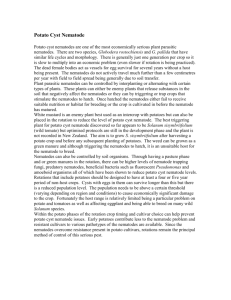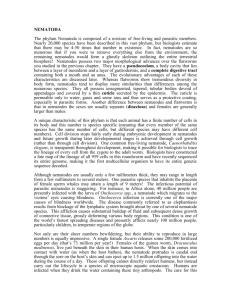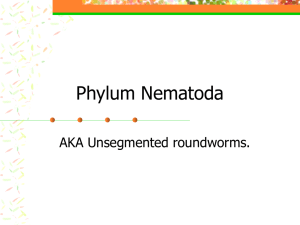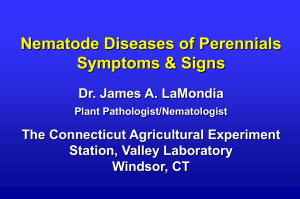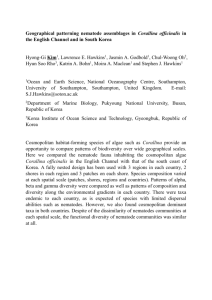Corn Nematodes
advertisement
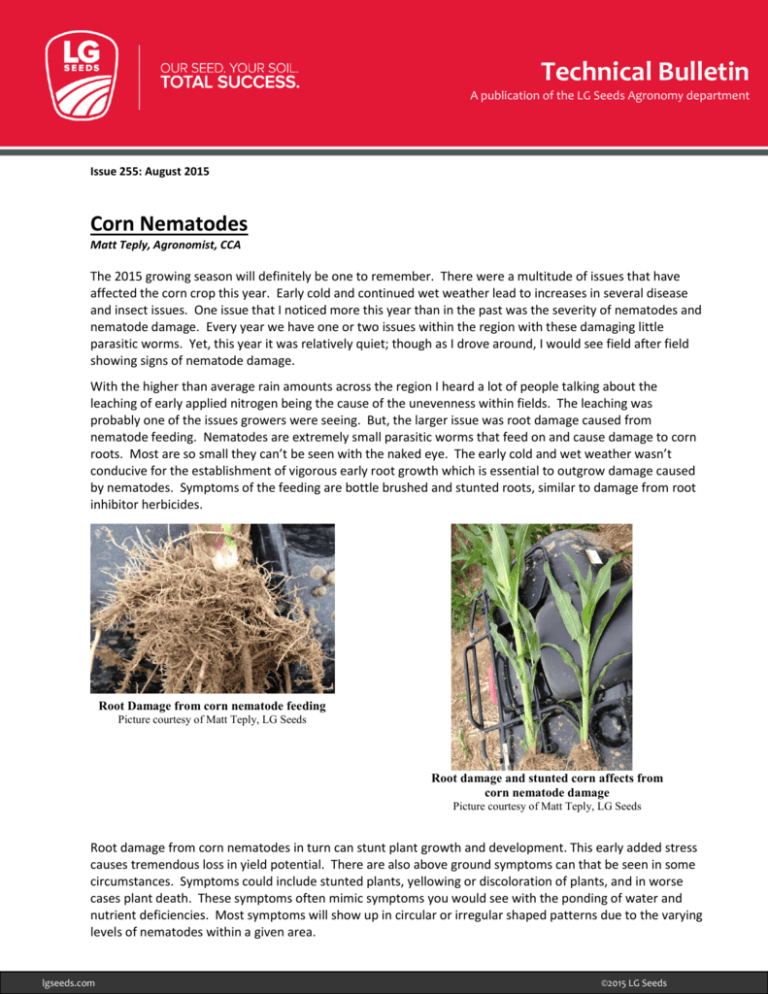
Technical Bulletin A publication of the LG Seeds Agronomy department Issue 255: August 2015 Corn Nematodes Matt Teply, Agronomist, CCA The 2015 growing season will definitely be one to remember. There were a multitude of issues that have affected the corn crop this year. Early cold and continued wet weather lead to increases in several disease and insect issues. One issue that I noticed more this year than in the past was the severity of nematodes and nematode damage. Every year we have one or two issues within the region with these damaging little parasitic worms. Yet, this year it was relatively quiet; though as I drove around, I would see field after field showing signs of nematode damage. With the higher than average rain amounts across the region I heard a lot of people talking about the leaching of early applied nitrogen being the cause of the unevenness within fields. The leaching was probably one of the issues growers were seeing. But, the larger issue was root damage caused from nematode feeding. Nematodes are extremely small parasitic worms that feed on and cause damage to corn roots. Most are so small they can’t be seen with the naked eye. The early cold and wet weather wasn’t conducive for the establishment of vigorous early root growth which is essential to outgrow damage caused by nematodes. Symptoms of the feeding are bottle brushed and stunted roots, similar to damage from root inhibitor herbicides. Root Damage from corn nematode feeding Picture courtesy of Matt Teply, LG Seeds Root damage and stunted corn affects from corn nematode damage Picture courtesy of Matt Teply, LG Seeds Root damage from corn nematodes in turn can stunt plant growth and development. This early added stress causes tremendous loss in yield potential. There are also above ground symptoms can that be seen in some circumstances. Symptoms could include stunted plants, yellowing or discoloration of plants, and in worse cases plant death. These symptoms often mimic symptoms you would see with the ponding of water and nutrient deficiencies. Most symptoms will show up in circular or irregular shaped patterns due to the varying levels of nematodes within a given area. lgseeds.com ©2015 LG Seeds The most common nematode found throughout the Corn Belt is the lesion nematodes and are the nematode related to most crop damage. Needle nematodes are probably the most devastating but are less frequently found. Stunt, stubby, lance, dagger, spiral, stunt, pin, and ring are other types nematodes found across the corn belt and are known to cause damage to corn. There continues to be a rise in issues associated with nematodes and nematode populations. Several factors lead into this. Farming practices continue to switch to more no-till and minimum till systems, thus disturbing the soil less frequently. The introduction of traits to control insects such has rootworm has greatly decreased the amount of soil-applied insecticides once used to control them. Counter and Counter 20CR were once widely used to control rootworm and was the only, and still the only, soil-applied nematicide in the market. Other issues that have led to the increased nematode populations include lack of crop rotations and the lack of grass control in crops. To help in the control and suppression of nematodes there are few options in corn. In the market today there is still some availability to, and the use of, soil-applied insecticides and nematicides. Again, Counter and Counter 20Cr are the only labeled soil-applied nematicides. The other options are seed-applied products. LG Seeds decided several years ago to use VOTiVO, a biological seed treatment offered by Bayer Crop Sciences. Bacterial spores are applied to the seed. As the seed germinates and the roots start to grow the bacteria begins its life cycle as well. The bacterial spores grow and feed off exudates given off by the roots as the corn plant grows. As the bacteria grows and feeds off the exudates, it basically covers the root in a protective layer, thus reducing the root surface area that nematodes have to feed on. With less root surface area out in the open, the nematodes basically starve to death. Picture courtesy of Bayer CropScience The use of VOTiVO and its biological control is not only very consistent in its results, but is extremely safe for humans and other non-target organisms. Chemical based compounds do not have these same attributes. Some intense nematode pressure has been seen in western Kansas and Nebraska where the use of both a soil-applied nematicide and a seed treatment are needed. Crop rotation is probably the best option in these situations. But, the economics of irrigated acres in the high plains often lead back to corn-on-corn. Nematode issues continue to spread across the Corn Belt and into various different soil types. Make sure you looking closely at your fields. Misdiagnosis of the issue is easy. If you think you may have an issue take samples to find out. It is important that when taking samples you send in both soil and root mass. Soil and root mass need to be intact and together if possible because nematodes will be found in both. Universities and labs are capable of diagnosing corn nematodes. This link to the University of Nebraska –Lincoln may help and clarify the sampling procedures. UNL Nematology Diagnostic Lab - Sample Submission = http://nematode.unl.edu/diagnostic_lab.htm I recommend that all LG Seeds seed corn purchased be treated with PONCHO 500/VOTiVO. We continue to find that year after year it just pays. Sources and Additional Information: 1. Interactive Diagnostic Key to Plant Parasitic, Freeliving and Predaceous Nematodes. http://nematode.unl.edu/key/nemakey.htm 2. Corn Nematodes. http://nematode.unl.edu/corn_nematodes.html Counter is a registered trademark of AMVAC Chemical Corporation. VOTiVO and Poncho are registered trademarks of Bayer CropScience. Note: The information in this issue is based upon field observations and third party information. Since variations in local conditions may affect the information and suggestions contained in this issue, LG Seeds disclaims legal responsibility therefore. Always read and follow label instructions. LG Seeds and design are trademarks of SCA Limagrain. lgseeds.com ©2015 LG Seeds



